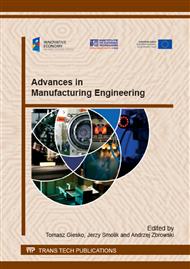[1]
Majcher A., Mrozek M., Zbrowski A., Olejniczak W., Pawłowski S., Piskorski M.: STM/AFM microscope for application in industrial advanced technologies and the high schools education. Maintenance Problems 3/2011, pp.177-188.
Google Scholar
[2]
Drelich J.: Atomic Force Microscopy in Adhesion Studies. Brill Academic Pub, (2005).
Google Scholar
[3]
Cohen S. H., Lightbody M. L.: Atomic Force Microscopy/Scanning Tunneling Microscopy. Springer, (2004).
Google Scholar
[4]
Chunli Bai: Scanning Tunneling Microscopy and Its Application. Springer Series in Surface Sciences, (2000).
Google Scholar
[5]
Shao-Kang Hung, En-Te Hwu, Ing-Shouh Hwang, Li-Chen Fu. Postfitting control scheme for periodic piezoscanner driving. Japanese Journal of Applied Physics, Vol. 45, 2006, pp. (1917).
DOI: 10.1143/jjap.45.1917
Google Scholar
[6]
Moeller G., Gerard P.: A step towards length scale corrected and instrument independent surface roughness analysis. Meas. Sci. Technol. 23, (2012), 105007.
DOI: 10.1088/0957-0233/23/10/105007
Google Scholar
[7]
Cleveland J.P., Anczykowski B., Schmid A.E., Elings V.B.: Energy dissipation in tapping-mode atomic force microscopy. Appl. Phys. Lett. 72, 2613 (1998).
DOI: 10.1063/1.121434
Google Scholar
[8]
Jeong Y., Jayanth G.R., Jhiang S.M., Menq C.H.: Direct tip-sample interaction force control for the dynamic mode atomic force microscopy. Appl. Phys. Lett. 88, 204102 (2006).
DOI: 10.1063/1.2203958
Google Scholar
[9]
Li H., Chen Y., Dai L.: Concentrated-mass cantilever enhances multiple harmonics in tapping-mode atomic force microscopy. Appl. Phys. Lett. 92, 151903 (2008).
DOI: 10.1063/1.2909535
Google Scholar
[10]
Bodiguel H., Montes H., Fretigny C.: Depth sensing and dissipation in tapping mode atomic force microscopy. Rev. Sci. Instr. 75, 2529 (2004).
DOI: 10.1063/1.1771495
Google Scholar
[11]
Patent application nr P. 397845 (2012).
Google Scholar
[12]
Ewers G., Marven C.: A Simple Approach to Digital Signal Processing, Texas Instruments Inc., ISBN: 0-904047-00-8.
Google Scholar
[13]
Stranneby D.: Digital Signal Processing and Applications. Elsevier, Burlington, MA (2004).
Google Scholar


